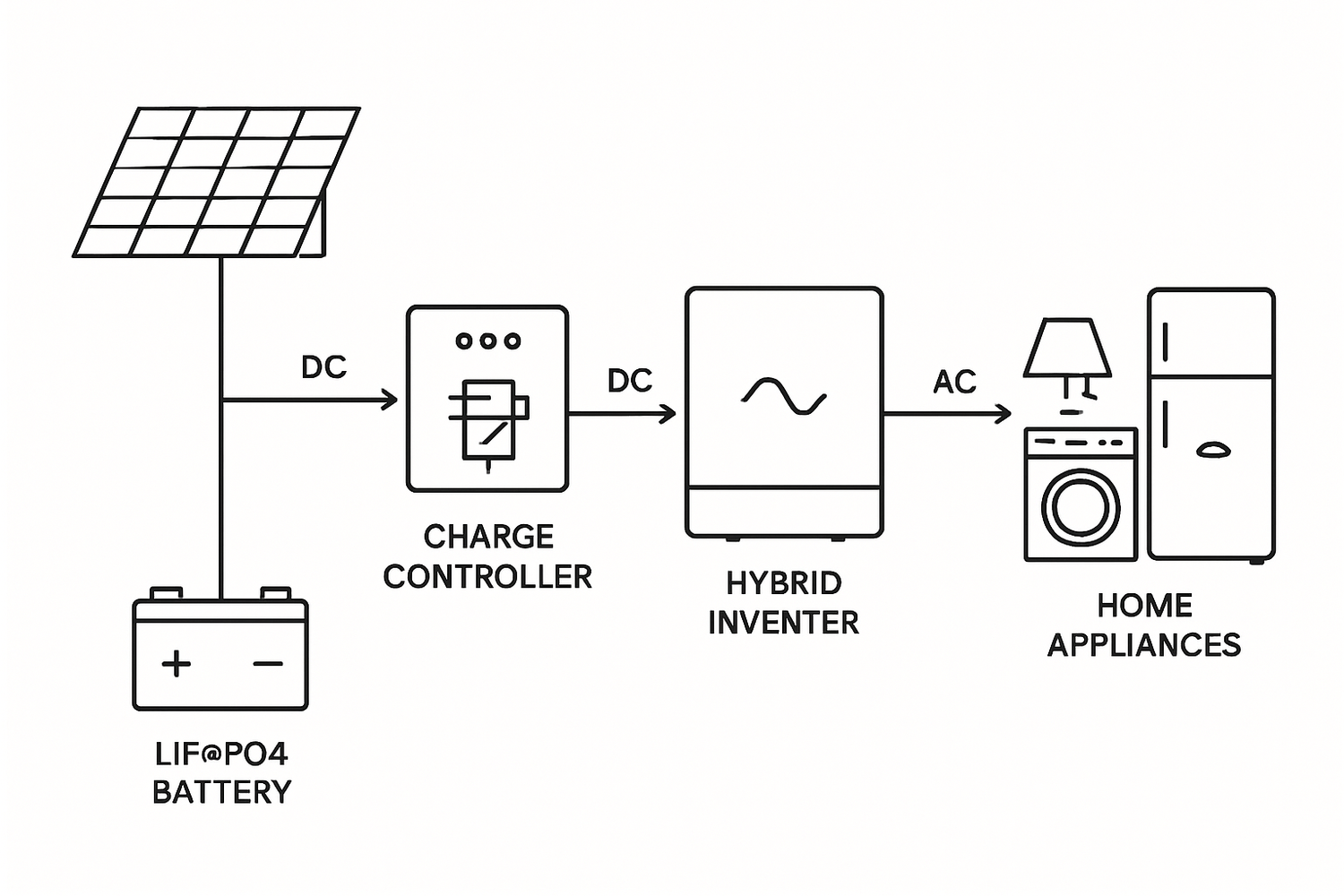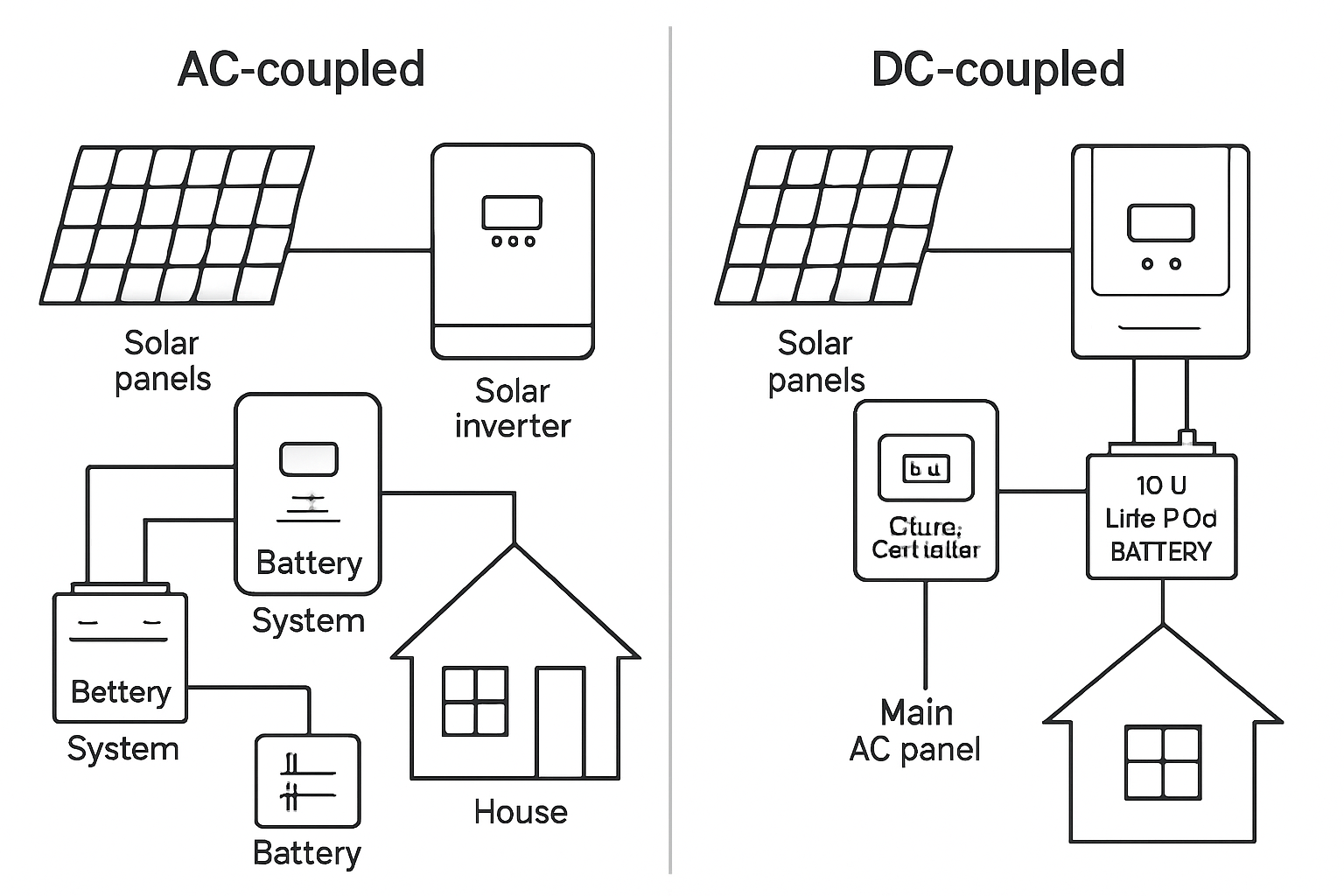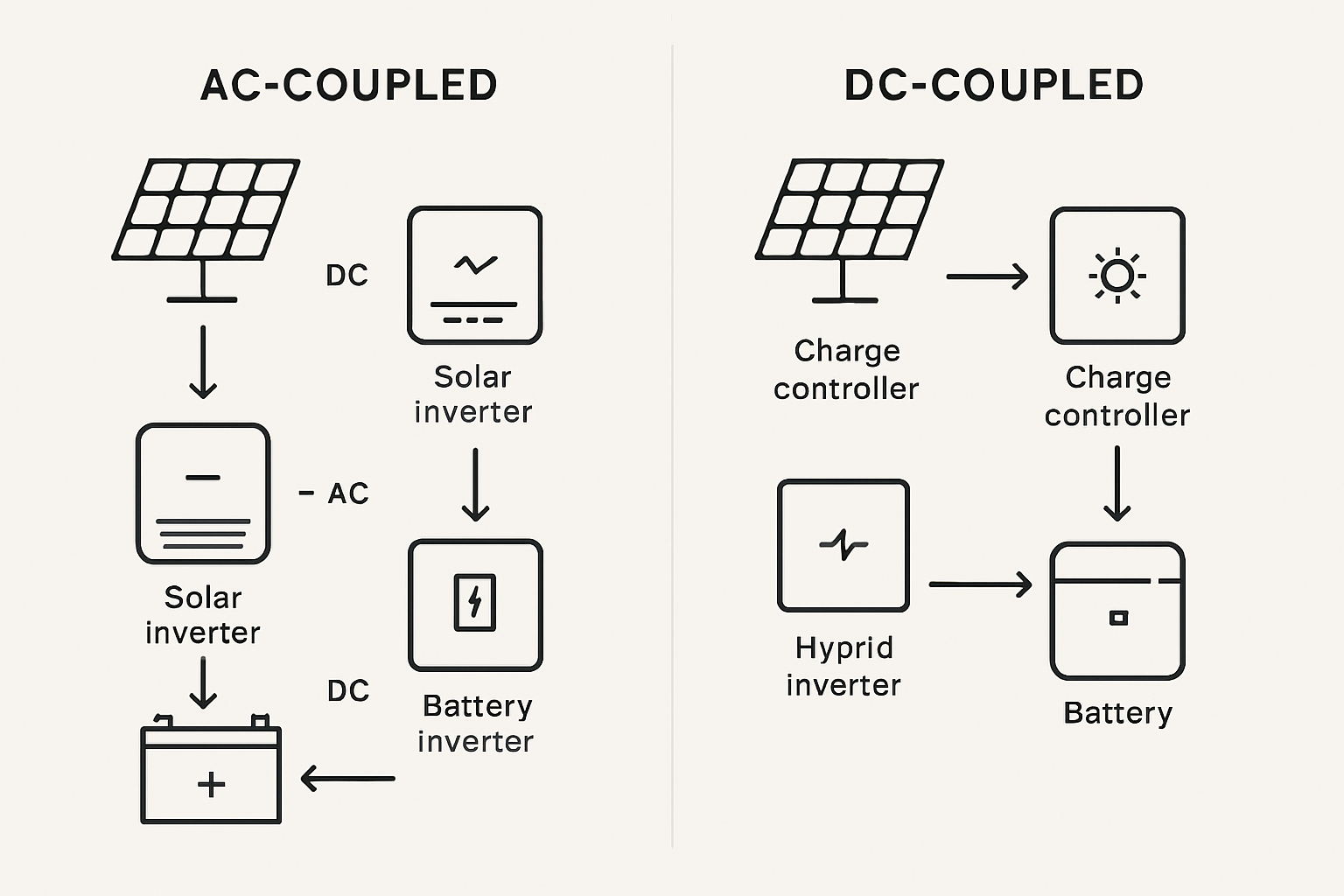Maximizing the energy harvested from solar panels is a primary goal for any home battery storage system. The configuration of your system plays a crucial role in its overall performance. A DC-coupled architecture, especially when paired with a Lithium Iron Phosphate (LiFePO4) battery, presents a highly efficient solution for storing and utilizing solar power. This approach minimizes energy loss, simplifies system design for new installations, and enhances reliability, helping you achieve greater energy independence.
The Fundamentals of DC Coupling in Solar Energy Systems
Understanding how solar energy is captured, stored, and converted is key to appreciating the benefits of a DC-coupled system. The entire process begins with the direct current (DC) electricity produced by your solar panels.
What is DC Coupling?
In a DC-coupled system, the DC power generated by solar panels is fed directly to a charge controller. This device regulates the voltage and current to safely charge the battery bank. The stored DC energy remains in that form until it's needed. A hybrid inverter then converts the DC power from either the solar panels or the battery into alternating current (AC) to power your home's appliances. This direct DC-to-DC connection between the panels and the battery is the defining feature of this architecture.
Key Components of a DC-Coupled Setup
A typical DC-coupled home battery storage system includes several core components working in harmony:
- Solar Panels: These capture sunlight and generate DC electricity.
- Charge Controller: This essential device manages the flow of DC power from the panels to the battery, preventing overcharging and optimizing the charging process.
- LiFePO4 Battery: The heart of the storage system, a lithium ion solar battery stores the excess energy for later use. Models like the 12v 100ah LiFePO4 lithium battery are popular for their balance of capacity and performance.
- Hybrid Inverter: This multi-function inverter handles the conversion of DC power to usable AC power for your home and can also manage power from the grid if connected.
Why LiFePO4 Batteries Excel in DC-Coupled Systems
The choice of battery chemistry is just as important as the system's architecture. LiFePO4 batteries offer a unique combination of efficiency, safety, and longevity that makes them an ideal match for DC-coupled solar applications.
The Efficiency Advantage: Minimizing Power Conversions
Every time electricity is converted from DC to AC or vice versa, a small amount of energy is lost as heat. AC-coupled systems, which are common for retrofitting existing solar arrays, must convert the DC power from panels to AC, and then back to DC to charge the battery. A DC-coupled system bypasses this redundant conversion, resulting in significantly higher round-trip efficiency. Systems can achieve efficiency levels above 95%, ensuring more of your generated solar power is stored and available for use. According to the U.S. Department of Energy, integrating storage is key to improving the affordability and reliability of solar technologies. Higher efficiency directly contributes to this goal.
Inherent Characteristics of LiFePO4 Chemistry
LiFePO4 batteries provide substantial advantages over other battery types. They are known for their excellent thermal and chemical stability, which greatly reduces the risk of overheating. This inherent safety is a critical consideration for any home energy system. Furthermore, LiFePO4 batteries boast a long cycle life, often capable of thousands of charge-discharge cycles before significant capacity degradation. This durability translates into a longer service life and better long-term value.
Seamless Integration and System Response
For new solar installations, a DC-coupled design offers a more streamlined and integrated solution. With fewer major components compared to some AC-coupled setups, the installation can be simpler. This architecture also allows for a rapid response when powering loads, as the inverter can draw DC power directly from the battery without delay, ensuring a stable and reliable power supply for your home.
Technical Considerations for Optimal Performance
To maximize the benefits of a DC-coupled LiFePO4 battery system, proper design and component selection are critical. Careful planning ensures your system operates efficiently and safely for years to come.
Sizing Your System Correctly
Properly sizing your solar array, charge controller, inverter, and battery bank is fundamental. The system must be balanced to meet your household's energy demands, especially during peak usage or periods of low solar generation. An undersized system may not provide sufficient power, while an oversized one can lead to unnecessary costs. A thorough analysis of your energy consumption patterns is the first step in designing an effective system.
The Role of the Battery Management System (BMS)
A sophisticated Battery Management System (BMS) is integral to the health and performance of a lithium phosphate battery. The BMS protects the battery cells from operational stresses like over-voltage, under-voltage, and extreme temperatures. It also ensures the cells are balanced, which maximizes the usable capacity and extends the battery's lifespan. The communication between the BMS and the hybrid inverter is vital for optimized charging and discharging cycles.
Comparing DC Coupling to AC Coupling
Choosing between system architectures depends largely on your specific situation. DC coupling is generally superior for new installations due to its higher efficiency and simpler design. AC coupling, however, offers more flexibility for adding battery storage to an existing grid-tied solar system.
| Feature | DC-Coupled System | AC-Coupled System |
|---|---|---|
| Battery Efficiency (Charging) | High (95-98%) | Lower (90-94%) |
| Best Use Case | New solar installations, off-grid systems | Retrofitting existing solar systems |
| System Complexity | More integrated, potentially simpler for new builds | Adds separate components, easier for retrofits |
| Conversion Steps (Solar to Battery) | One (DC to DC) | Two (DC to AC, then AC to DC) |
Real-World Applications and Benefits
The combination of DC coupling and LiFePO4 technology provides tangible benefits, from enabling off-grid lifestyles to reducing utility bills in suburban homes. The growth in residential energy storage, as noted by the International Energy Agency, is a critical part of the global transition to cleaner energy.
Off-Grid Living and Energy Independence
For off-grid homes, farms, or cabins, efficiency is paramount. A DC-coupled system is the standard choice for these applications because it maximizes the use of every watt generated. By minimizing conversion losses, the system can more effectively charge a lithium battery pack, ensuring a reliable power supply through the night and during cloudy weather. This robust performance is essential for true energy independence.
Maximizing Self-Consumption in Grid-Tied Homes
Even in a grid-tied home, a DC-coupled LiFePO4 system offers significant advantages. It allows you to store excess solar energy produced during the day with minimal loss. You can then use this stored energy in the evening when electricity rates are often higher, reducing your reliance on the utility grid and lowering your energy bills. For a deeper dive into how different factors impact storage performance, you can review this ultimate reference on solar storage performance.
A Forward-Looking Perspective on Energy Storage
Choosing a DC-coupled LiFePO4 battery system is a strategic decision for anyone building a new solar energy solution. The superior battery efficiency, driven by a more direct energy path from the sun to storage, ensures you get the most out of your investment. This architecture, combined with the safety and longevity of LiFePO4 chemistry, creates a powerful and dependable energy storage solution. It empowers you to take control of your energy usage, reduce your environmental footprint, and build a more resilient home.
Frequently Asked Questions
Is a DC-coupled system always more efficient than an AC-coupled one?
While DC-coupled systems generally have higher round-trip efficiency because they avoid extra power conversions when charging the battery from solar panels, the overall system efficiency can depend on usage patterns. The primary efficiency gain is in the process of storing solar energy. For powering AC loads directly from the sun when the battery is full, both systems perform similarly.
Can I add a DC-coupled battery to my existing solar panel system?
Adding a DC-coupled battery to an existing system that uses a standard grid-tie inverter is complex and often not practical. DC-coupled systems are best suited for new installations where the solar array, charge controller, inverter, and battery are designed to work together from the start. Retrofitting an existing system is typically easier with an AC-coupled battery.
What is the typical lifespan of a LiFePO4 battery in a solar storage system?
High-quality LiFePO4 batteries, like a 12v 100ah lithium ion battery, can last for thousands of cycles. A typical lifespan can range from 10 to 15 years or more, depending on the depth of discharge, operating temperature, and the quality of the Battery Management System (BMS). Their longevity makes them a cost-effective choice for long-term energy storage.





Leave a comment
All comments are moderated before being published.
This site is protected by hCaptcha and the hCaptcha Privacy Policy and Terms of Service apply.